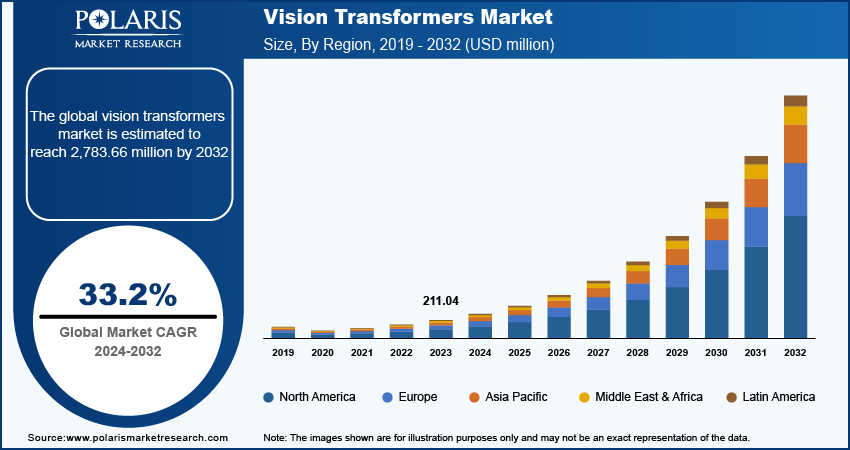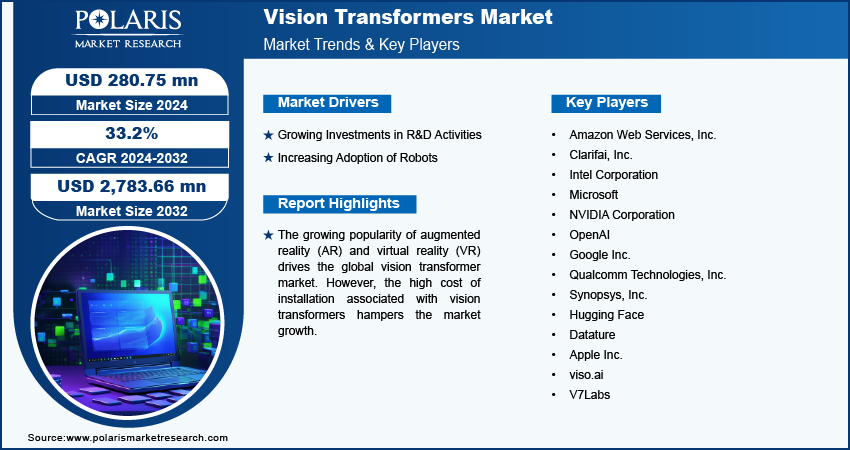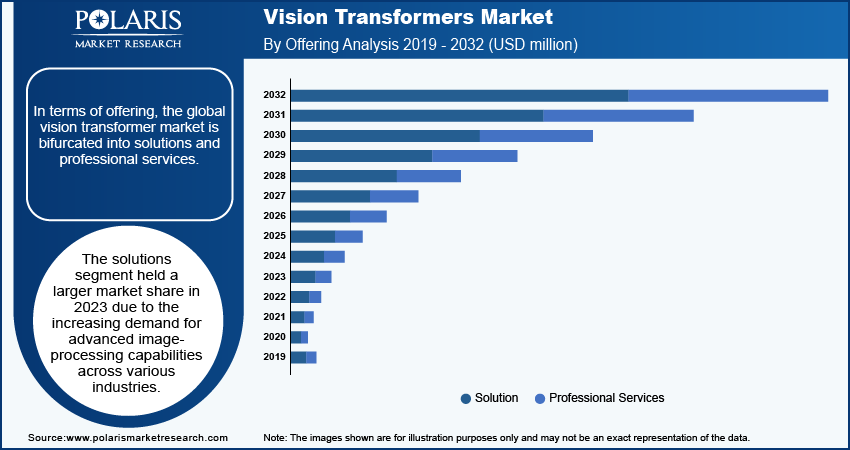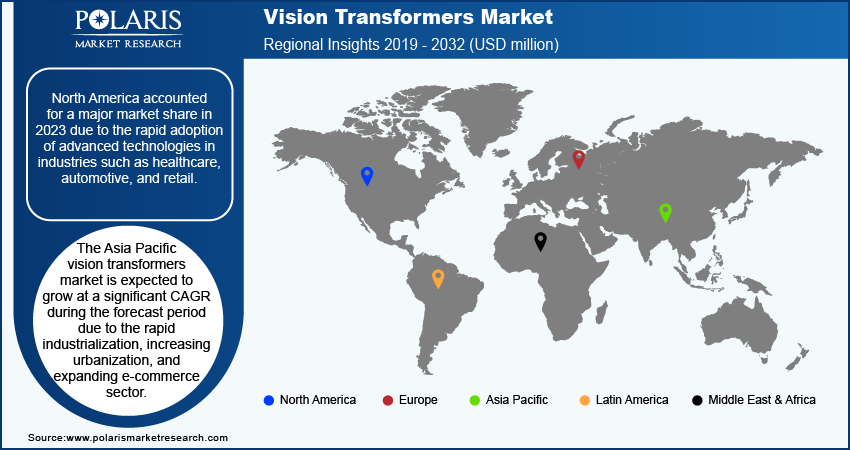
Vision Transformers Market Size, Share, Trends, Industry Analysis Report: By Offering [Solution (Hardware and Software) and Professional Services (Consulting; Deployment & Integration; and Training, Support, & Maintenance)], Application, Vertical, and Region (North America, Europe, Asia Pacific, Latin America, and Middle East & Africa) – Market Forecast, 2024–2032
- Published Date:Oct-2024
- Pages: 114
- Format: PDF
- Report ID: PM5114
- Base Year: 2023
- Historical Data: 2019-2022
Vision Transformers Market Overview
The vision transformers market size was valued at USD 211.04 million in 2023. The market is projected to grow from USD 280.75 million in 2024 to USD 2,783.66 million by 2032, exhibiting a CAGR of 33.2% during 2024–2032.
Vision transformers (ViTs) represent a significant advancement in the field of computer vision, leveraging the transformer architecture originally developed for natural language processing (NLP). Vision transformers transform the working of machines' processes and understanding of visual data, achieving remarkable results across various tasks.
The growing popularity of augmented reality (AR) and virtual reality (VR) drives the global vision transformer market growth. AR and VR involve high-resolution imagery and complex visual environments. ViTs efficiently process and analyze these large datasets, improving the realism and interactivity of virtual experiences.
The increasing popularity and adoption of autonomous vehicles across the globe fuel the growth of the global vision transformer market. Autonomous vehicles rely heavily on ViTis to enhance vehicle safety by interpreting their surroundings. ViTs enable accurate identification and classification of objects such as pedestrians, other vehicles, traffic signs, and obstacles. This increases the demand for ViTis in autonomous vehicles.

To Understand More About this Research: Request a Free Sample Report
The vision transformers market is driven by their superior performance in handling complex visual tasks. ViTs achieve high levels of accuracy in image classification, object detection, and segmentation tasks, making them attractive for various applications such as security and surveillance, healthcare and medical imaging, and others.
Vision Transformers Market Driver Analysis
Growing Investments in R&D Activities
Increased R&D funding leads to the development of advanced ViTs, improving their performance in tasks such as image recognition, object detection, and video analytics. This attracts industries seeking advanced solutions such as vision transformers. For instance, in November 2022, V7 Labs, an AI company, raised USD 33 million to automate training data for computer vision AI models. Such growing investments in R&D activities drive the vision transformers market growth.
Increasing Adoption of Robots
The adoption of robots is increasing worldwide. According to data published by the International Federation of Robotics, there were 3.9 million operational robots in the world in 2022. Robots require advanced vision systems for tasks such as navigation, object recognition, and interaction with the environment. ViTs provide superior performance in these areas, making them essential for robotic applications. Thus, the rising adoption of robots drives the market growth.

Vision Transformers Market Segment Insights
Vision Transformers Market Breakdown By Offering
In terms of offering, the global vision transformer market is bifurcated into solutions and professional services. The solutions segment held a larger market share in 2023 due to the increasing demand for advanced image-processing capabilities across various industries. The rise of applications in sectors such as healthcare, automotive, and retail played a significant role in this growth. Organizations rely heavily on software solutions that leverage advanced algorithms to process and analyze visual data efficiently as they invest in developing smarter technologies, ultimately leading to better decision-making and enhanced user experiences.
The professional services segment is projected to grow at a robust pace in the coming years, owing to the growing focus on data security and compliance. Companies want to navigate the evolving landscape of regulations and best practices, positioning professional services as essential for successful deployments. Therefore, as the market matures, organizations are estimated to increasingly rely on specialists to maximize the value of their investments in intelligent visual systems.
Vision Transformers Market Breakdown By Vertical
Based on verticals, the global vision transformers market is segmented into retail & e-commerce, media & entertainment, automotive, government & defense, healthcare & life sciences, and others. The healthcare & life sciences segment dominated the market in 2023 due to the rising need for advanced imaging solutions and automated diagnostics. Healthcare providers increasingly rely on intelligent systems to analyze medical images, detect anomalies, and assist in treatment planning. The growing emphasis on precision medicine and personalized healthcare further fueled the adoption of these technologies. Additionally, the rising volume of medical data and the integration of AI in telehealth applications contributed to the segment expansion.
The retail & e-commerce segment is expected to grow at a significant CAGR during the forecast period owing to the rising need to enhance customer experiences and optimize inventory management. The shift toward online shopping has prompted businesses to leverage advanced visual recognition capabilities for personalized recommendations and targeted advertising. Furthermore, companies are using these technologies to analyze consumer behavior through in-store cameras, enabling them to adapt effective marketing strategies in real time.

Vision Transformers Regional Insights
By region, the study provides the vision transformers market insights into North America, Europe, Asia Pacific, Latin America, and the Middle East & Africa. North America accounted for a major market share in 2023 due to the rapid adoption of advanced technologies in several industries such as healthcare, automotive, and retail. The US, in particular, dominated the regional market, fostering innovation through robust funding for AI initiatives and a favorable regulatory environment. Additionally, the increasing demand for automation and intelligent analytics in various sectors significantly contributed to market growth.

The Asia Pacific vision transformers market is expected to register a significant CAGR during the forecast period due to the rapid industrialization, increasing urbanization, and expanding e-commerce sector. Countries such as China and Japan are at the forefront of this shift, with significant investments in AI and machine learning technologies. The rising adoption of smart devices and the growing emphasis on digital transformation across industries further accelerate demand. Moreover, the Asia Pacific market benefits from a large consumer base that drives the need for enhanced visual recognition solutions in retail and security applications.
Vision Transformers Market – Key Players and Competitive Insights
Key market players are investing heavily in research and development to expand their offerings, which will boost the vision transformers market growth in the coming years. Market participants are also undertaking a variety of strategic activities, including innovative launches, international collaborations, higher investments, and mergers and acquisitions between organizations, to expand their global footprint. To expand and survive in a more competitive and rising market environment, the vision transformers industry must offer innovative solutions.
The vision transformers market is fragmented, with the presence of numerous global and regional market players. A few major players in the vision transformers market are Amazon Web Services, Inc.; Clarifai, Inc.; Intel Corporation; Microsoft; NVIDIA Corporation; OpenAI; Google Inc.; Qualcomm Technologies, Inc. Synopsys, Inc.; Hugging Face; Datature; Apple Inc.; viso.ai; and V7Labs.
Clarifai, Inc., founded in 2013 an AI company specializing in computer vision technologies. It provides a comprehensive platform that enables businesses to build, deploy, and manage AI applications efficiently. Clarifai's offerings include solutions for image and video recognition, data labeling, and generative AI, allowing organizations to leverage advanced machine learning capabilities across various sectors, such as healthcare, retail, and media. In May 2022, Clarifai released Clarifai 8.4 for caption generation, printed OCR, grammar correction, and logo detection.
OpenAI, founded in 2015, is an AI research company known for developing advanced language models such as GPT. OpenAI aims to ensure that artificial general intelligence (AGI) benefits humanity. The organization conducts research across various AI domains, including natural language processing, robotics, and computer vision. In January 2021, OpenAI released two transformer models that link language and computer vision.
Key Companies in Vision Transformers Market
- Amazon Web Services, Inc.
- Clarifai, Inc.
- Intel Corporation
- Microsoft
- NVIDIA Corporation
- OpenAI
- Google Inc.
- Qualcomm Technologies, Inc.
- Synopsys, Inc.
- Hugging Face
- Datature
- Apple Inc.
- viso.ai
- V7Labs
Vision Transformers Industry Developments
May 2024: Datature, an innovative AI Vision platform, introduced vision transformers (ViT) models to improve segmentation for complex datasets.
May 2024: Microsoft, a US-based multinational corporation and technology company, announced the launch of GigaPath, a vision transformer that achieves whole-slide modeling through the use of dilated self-attention techniques.
January 2024: Apple Inc., a multinational technology company, announced the deployment of attention-based vision transformers to Apple's neural engine.
Vision Transformers Market Segmentation
By Offering Outlook (Revenue, USD million, 2019–2032)
-
Solution
- Hardware
- Software
- Professional Services
- Consulting
- Deployment & Integration
- Training, Support, & Maintenance
By Application Outlook (Revenue, USD million, 2019–2032)
- Image Classification
- Image Captioning
- Image Segmentation
- Image Detection
- Other
By Vertical Outlook (Revenue, USD million, 2019–2032)
- Retail & Ecommerce
- Media & Entertainment
- Automotive
- Government & Defense
- Healthcare & Life Sciences
- Other
By Regional Outlook (Revenue, USD million, 2019–2032)
- North America
- US
- Canada
- Europe
- Germany
- France
- UK
- Italy
- Spain
- Netherlands
- Russia
- Rest of Europe
- Asia Pacific
- China
- Japan
- India
- Malaysia
- South Korea
- Indonesia
- Australia
- Rest of Asia Pacific
- Middle East & Africa
- Saudi Arabia
- UAE
- Israel
- South Africa
- Rest of Middle East & Africa
- Latin America
- Mexico
- Brazil
- Argentina
- Rest of Latin America
Vision Transformers Report Scope
|
Report Attributes |
Details |
|
Market Size Value in 2023 |
USD 211.04 million |
|
Market Size Value in 2024 |
USD 280.75 million |
|
Revenue Forecast by 2032 |
USD 2,783.66 million |
|
CAGR |
33.2% from 2024 to 2032 |
|
Base Year |
2023 |
|
Historical Data |
2019–2022 |
|
Forecast Period |
2024–2032 |
|
Quantitative Units |
Revenue in USD Million and CAGR from 2024 to 2032 |
|
Report Coverage |
Revenue Forecast, Market Competitive Landscape, Growth Factors, and Trends |
|
Segments Covered |
|
|
Regional Scope |
|
|
Competitive Landscape |
|
|
Report Format |
|
|
Customization |
Report customization as per your requirements with respect to countries, regions, and segmentation. |
FAQ's
The vision transformers market size was valued at USD 211.04 million in 2023 and is projected to grow to USD 2,783.66 million by 2032.
The market is projected to register a CAGR of 33.2% during 2024–2032.
North America held the largest share of the global market in 2023.
A few key players in the market are Amazon Web Services, Inc.; Clarifai, Inc.; Intel Corporation; Microsoft; NVIDIA Corporation; OpenAI; Google Inc.; Qualcomm Technologies, Inc.; Synopsys, Inc.; Hugging Face; Datature; Apple Inc.; viso.ai; and V7Labs.
The professional services segment is projected for significant growth in the global market during the forecast period.
The healthcare & life sciences segment dominated the vision transformers market in 2023.
